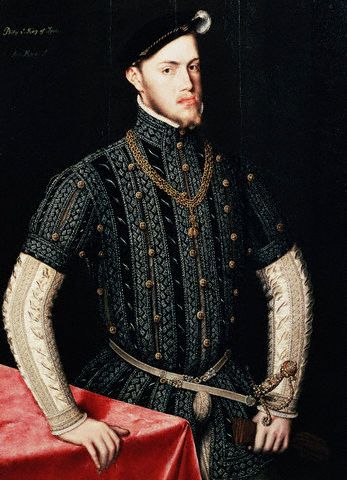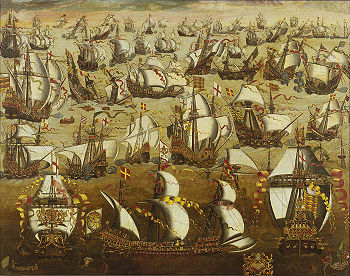
The Spanish Armada
Relationships between England and Spain were supposed to be close and warm. After all, King Phillip II's wife was Queen regnant of England, which made Philip himself co-monarch. But by the 1570s, Mary I had died and Philip was left with his sister-in-law Elizabeth. It’s safe to say that she wasn’t among his favourite people.

Maybe it all goes back to the day when Phillip II proposed to her after Mary's death and she refused him. But she also had a clear conflict with the Spanish school of thought.
First, she was a Protestant, which was a terrible sin in the eyes of a devout Catholic like Philip. Then, she enjoyed teasing him by sending her favorite pirate, Francis Drake, to loot the ships that came from the Americas loaded with treasures. She also supported the Low Countries in their revolt against Spanish dominance and, ultimately, aimed to expand Protestantism wherever possible.
So Phillip II decided to do what he did best: go to war. He would attack the English territory, remove Elizabeth from the throne and burn all the Protestant heretics at the stake. Faith was an important angle here, as it gained the monarch permission from the Pope Sixtus V - he envisioned such an invasion as a new form of crusade.
All this made the project very exciting: Phillip put all of his Portuguese subjects to work along with the Spanish to create a mega-army and join in a mega-armada that would fight in the name of the Lord, and show the heathens an intensive Spanish lesson.
For the Spanish it was all so promising.
The Great and Most Fortunate Navy - The Spanish Armada

In fact, its figures alone were staggering: 28 newly-constructed warships out a total of 123 vessels. 8,000 sailors. 18,000 soldiers. 1,000 iron guns. 1,500 brass guns. The blessing of the banner recreated that of the battle of the successfully historic Lepanto.
England was genuinely scared of the rumours coming from Spain. Elizabeth sent Francis Drake to destroy as many ships as he could in Cadiz, which he did. Philip II collected more money from the crusades fund and rebuilt. Nothing was going to stand in the way behind him and victory.
Not even when the commander of the whole affair, experienced and prestigious Álvaro de Bazán died. Phillip simply put the Duke of Medina Sidonia (this family had, after all, conquered Melilla for Spain) in charge.
Nervous, Elizabeth put Francis Drake in charge of a group of solider's to fight Spain's army of 55,000.
On July, 1588, the Spanish Armada set sail.
God Blew
It was a catastrophe.
Even though the Spaniards were off to a good start, battling the English in Plymouth with a firepower superiority of about 50%, soon everything that could go wrong went wrong. The Spanish Armada was delayed by the bad weather that could be expected from England at any time of year. The English put this to their advantage. They simply stayed out of Spain's shooting range and used the strong winds to best effect. Their advanced warfare allowed them to shoot from afar. Not even the best Spanish class of warmongering had prepared them for this.
The members of the Great and Most Fortunate Navy, the Invincible Armada, were swatted like flies. They had to escape in defeat.
And then bad luck -that same bad luck that killed Álvaro de Bazán and had sent Francis Drake off to destroy their ships- struck again with even more might: a fierce storm broke out, sinking most of what ships had managed to remain standing. The rest of the vessels were only kept afloat because the wooden surface of their hulls was tied by cables and the horses were thrown over board.
On September 13, 1588, the Spanish Armada returned home. Three quarters of their men had died. Half of the ships were sunk.
After overspending and sinking in debt for wars over centuries, Spain was finally bankrupt.
The bad times had begun.
